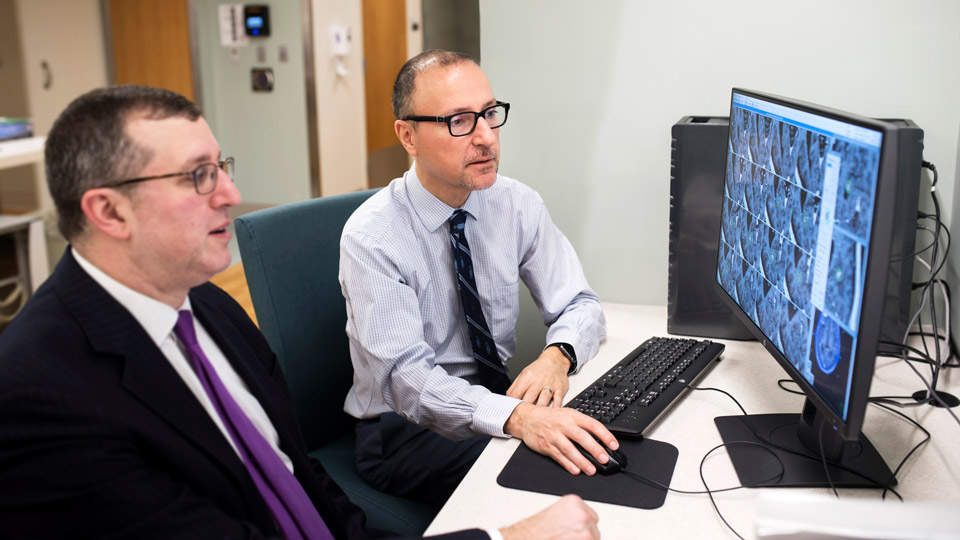Radiation Therapy for Sinonasal Cancer
Doctors at NYU Langone may use radiation therapy, or energy beams, to destroy any sinonasal cancer cells that remain after surgery.
They may also use radiation therapy—with or without chemotherapy—before surgery to shrink sinonasal tumors. Shrinking tumors can make them easier to surgically remove and also helps to preserve critical structures, such as the eye.
Radiation therapy may be a treatment option for people who cannot have surgery due to poor health. It may also be used with or without chemotherapy for people with sinonasal lymphoma, because this form of cancer tends to respond better to radiation therapy than surgery.
Radiation Therapy Planning
Radiation oncologists at NYU Langone use CT scans and software to create personalized treatment plans for sinonasal cancer. Using the CT scans, the software creates three-dimensional pictures of the tumor. It also shows structures surrounding the nasal and paranasal cavities, such as the optic nerve, which runs from the eye to the brain; the cochlea, the part of the inner ear that processes sound; the base of the skull, brain, and brainstem; and important blood vessels and nerves.
These images help doctors deliver highly targeted radiation doses to the tumor and avoid healthy tissue.
Intensity Modulated Radiation Therapy
Doctors at NYU Langone usually prescribe intensity modulated radiation therapy to manage sinonasal cancer. With this therapy, the radiation beams come from different directions and are broken into many small, computer-controlled doses of varying strengths.
Tailored to the size, shape, and location of the sinonasal cancer, these precise beams enable doctors to deliver high doses of radiation directly to the tumor and avoid nearby healthy tissue. Treatment is delivered in fractions—typically once daily, five days a week, for six or seven weeks.
When radiation therapy is given before surgery, doctors may monitor the tumor as it shrinks and adjust the radiation treatment plan to account for the change in size. They can also reduce the dose delivered to critical structures, such as the optic nerves, brain, and brainstem.
Stereotactic Radiosurgery or Gamma Knife Surgery
Doctors at NYU Langone’s Center for Advanced Radiosurgery may use stereotactic radiosurgery—also called Gamma Knife® surgery—to manage certain sinonasal tumors and tumors that have not been completely removed during surgery.
Despite the name, Gamma Knife® is not a knife but rather a system for delivering precisely targeted radiation treatment. Gamma Knife® surgery may be used to boost the radiation dose to the remaining tumor after intensity modulated radiation therapy is complete.
Working together, our neurosurgeons and radiation oncologists use highly detailed MRI or CT images to create a customized treatment plan. Then, the Gamma Knife® system directs multiple highly targeted radiation beams to the tumor in a single treatment session. Important nearby structures, such as nerves and blood vessels in the skull base, are spared from a higher radiation dose.

The goal of Gamma Knife® surgery is to deliver radiation beams only to precisely targeted areas. People being treated wear a head frame during the procedure, which prevents head movement.
Gamma Knife® surgery is an outpatient procedure and usually takes a few hours to complete.
Managing Side Effects of Radiation Therapy
Side effects of radiation therapy for sinonasal cancer may include dry eye, vision problems, hearing loss from fluid and inflammation in the ear, dry mouth, and a loss of appetite. Highly targeted radiation therapy and carefully controlled doses help minimize these side effects.
NYU Langone doctors offer rehabilitation programs and support services to address any discomfort or health problems that may arise. Many side effects may subside after radiation therapy is complete.
Meet Our Doctors
Perlmutter Cancer Center specialists provide care and support during treatment.
Browse Doctors